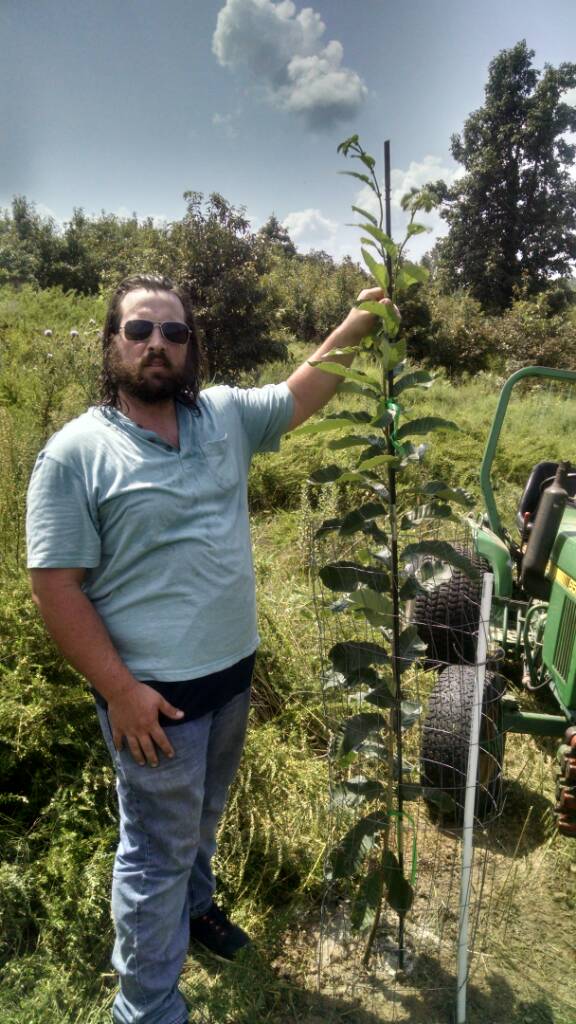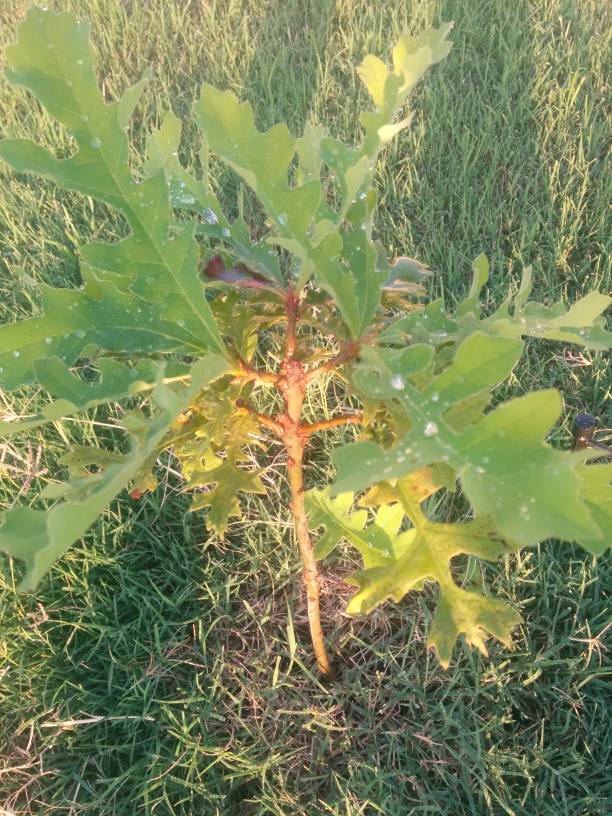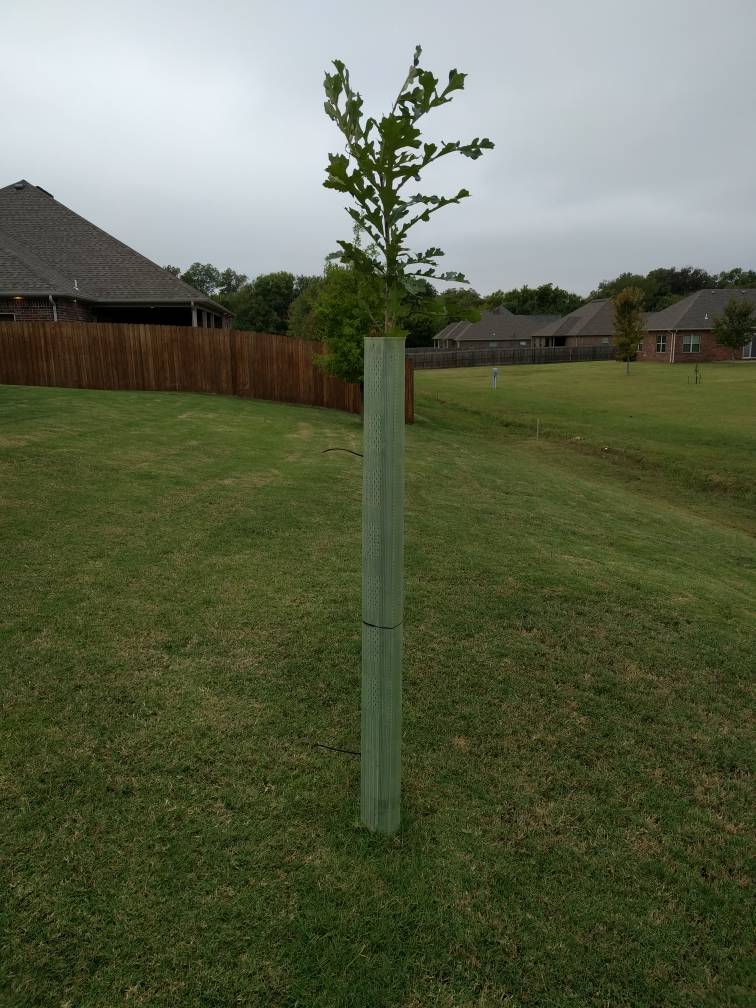-
The forum has been upgraded to support both light and dark themes. Click here for directions.
You are using an out of date browser. It may not display this or other websites correctly.
You should upgrade or use an alternative browser.
You should upgrade or use an alternative browser.
Show Your Tree Seedlings Thread
- Thread starter Fish
- Start date
Native Hunter
Well-Known Member
Good grief, Native. You'll be hanging a stand in those things in a year or two!
LOL, they have done well for sure. Of course I cheated - I dug a huge root ball of dirt - so large that the trees didn't get set back any at all from transplanting. When spring came and time to start growing again, they were ready to take off in the new location!
That fence is chest high, so it illustrates how quickly they have grown.
Murdog
Member
Holy single season growth!!
This was my biggest wbp Chinese chestnut from seed this year. I had a Dunstan I planted out bigger then this one. Ill try to grab a pick of it next time I head up to our place. And when I get back to the house ill show what I still have in pots.
Sent from my XT1080 using Tapatalk
Fish
Well-Known Member
LOL, they have done well for sure. Of course I cheated - I dug a huge root ball of dirt - so large that the trees didn't get set back any at all from transplanting. When spring came and time to start growing again, they were ready to take off in the new location!
That fence is chest high, so it illustrates how quickly they have grown.
So you dug them when dormant in the fall?
Native Hunter
Well-Known Member
So you dug them when dormant in the fall?
Yes, the fall of 2014, and I set them out in the new locations the same day I dug them. So, the growth they have achieved was through the growing seasons of 2015 and 2016.
Underneath the tree was fescue sod, so it was easy to cut a big chunk of soil out of the ground without it falling apart. The grass roots + seedling roots held the soil together. I don't know how chestnuts worked their way down through that sod and sprouted, but they did. I dug at least 10 seedlings up under that tree that year. This was in a yard near a house, so perhaps that explains why deer didn't gobble up all the chestnuts that fell. I've never seen a chestnut seedling emerge from under a tree at my farm. They all must get eaten.
I need to go check under that tree again this year to see if there are any more that have come up. The mother tree is in the path of a new road coming through and will be gone for good when the dozers final move in.
Fish: you pretty well nailed it my friend. Just few minor points that might enhance your success if you choose to try this method: 1st, cut the top of the carton off above the handle (I use a large pair of snips) so you have the handle available when you plant the carton and especially when you dig the carton to plant the tree in it's final location. 2nd, cut out ALL 4 corners (about 3" up) from the bottom of the carton so roots will develop in all 4 directions, water very heavily when you dig the in-ground container to plant the seedling in it's final location since the water acts as a lubricant and will allow you to get longer roots that don't break off so quickly, 3rd, place the cartons in a trench (you can use a circle, square or rectangle nursery pattern) about 3 inches apart so each tree has root-growing room, 4th, use a razor knife (sometimes called box cutter) to slit 3 sides of the carton when replanting because it will give you a nice block of dirt (remember it's wet) that protects/retains the small fiberous roots close to the surface. I tend to start acorns in rows of 15 milk cartons; I place a small amount of straw on the top of each carton at the initial planting for moisture retention, and of course I provide protection by placing hardware cloth covers I have designed for the system. Attached is a photo of a 4-mo old Regal Prince columnar white oak with excellent shape/form including girth in relation to it's height. Finally, I direct seed most oaks in their final location whenever possible; I grow some container trees (essentially direct seeded into a milk carton) to gift to others or to use as replacements if an tree is severely damaged or destroyed. One final note; you can plant container trees in the fall or spring ... I experience a little higher germination rate with spring plantings but I plant enough that it doesn't make any difference to me. Try it ... you might like it!


Attached is a photo of Swamp White Oaks in early June about 3+ mo old. It shows clearly my planting method and please note not every carton has a tree. I believe one of the 2 cartons not showing a tree did finally produce a seedling; however, it was not a robust growing plant and was discarded. Please give me a shout if I can be of help to you or any of our tree friends.

Note also these containers are not spaced very far apart; sometimes I just line them up in the trench ... but you will get better root structure if you space them out a little. I have also tried gallon cartons but I didn't believe the marginal gain was very much. Maybe yours would do better.
I guess I'm either a slow worker or have too many irons in the fire - so to speak -but I just don't enjoy the effort it takes to grow trees above ground (lots of people probably do and produce trees superior to mine). This way I plant them, protect them and pretty much forget about them (I do monitor the moisture situation; however the earth insulates and avoids extreme variations in temperature that you may get with trees in containers above ground) until I want them as transplants.

Note also these containers are not spaced very far apart; sometimes I just line them up in the trench ... but you will get better root structure if you space them out a little. I have also tried gallon cartons but I didn't believe the marginal gain was very much. Maybe yours would do better.
I guess I'm either a slow worker or have too many irons in the fire - so to speak -but I just don't enjoy the effort it takes to grow trees above ground (lots of people probably do and produce trees superior to mine). This way I plant them, protect them and pretty much forget about them (I do monitor the moisture situation; however the earth insulates and avoids extreme variations in temperature that you may get with trees in containers above ground) until I want them as transplants.
Last edited:
Champdog21
Member
Oakseeds, Do you trim the roots at all when you replant them or what? I may have missed you saying exactly how you replant them out of the container once you dig them up with the roots being that big.
Oakseeds, Do you trim the roots at all when you replant them or what? I may have missed you saying exactly how you replant them out of the container once you dig them up with the roots being that big.
Fortunately, I plant most of these container trees in Illinois where the topsoil often runs very deep; consequently, I usually can dig a hole 20+ inches deep without running out of good soil. I try to dig a hole deeper than the longest root and wide enough to accommodate multiple roots growing in different directions. When I actually plant the tree, I hold it in the hole and replace dirt slowly so the roots are directed straight downward with the base of the tree slightly above the soil/ground line. I water the newly planted tree well to ensure root/soil contact and to settle the soil in the planting hole. After a good dose of water, I can see if the planted tree has settled below the ground line; if so, I gently pull it up to be level and avoid potential future crown rot. The water acts as a lubricant and makes it easy to pull the tree up in the ground to the appropriate height. If you dig in-ground container trees after a good rain (say 2+ inches) you will be amazed at the length of tap root that slides out of the ground; I dug some chestnut container trees one time that had a tap root (out of the ground) that was in excess of 3-4 feet. Obviously, I had to cut those tap roots when replanting the trees. Again, with the soils I usually plant in, I try to save as much root structure as possible. Here are other chestnut seedlings (some of my early efforts) with decent root structures ... a little less then typically what I recover now as root structure when I transplant.... probably because I had only made 2 bottom corner cuts in the in-ground containers (learn as I go ... BUT probably resulted in less opportunity for root development (with only 2 corners removed) and eventually uptake of water and nutrients. Hope this helps

Champdog21
Member
Yes it does thanks for taking the time to thoroughly answer my question
jteeen
Active Member
This is cheating since it is in my yard and gets fertiziler from my grass, but this Bur Oak I got for free from the state. First summer in the ground it did nothing. This year it has exploded out of a 5' tube. It is now pushing 7', with 6' of growth in one growing season. It's catching up to my 45 gallon shumard in the background that has been in the ground two years. Black line on the tube is 4/29/16.


Sent from my Nexus 5X using Tapatalk


Sent from my Nexus 5X using Tapatalk
Redneck
Member
Thanks, I grew 30 apple trees from seed, I planted 20 and keep 10 in pots to be planted this winter in a diffrent locationNice looking apple trees, Redneck. Are they grown from seed? Will you graft all of them?
Looks like you grew some nice oaks as well. They should take off great next spring! Thanks for sharing.
That would be great, I have 2 Anna's and 2 golden delicious trees that are 3rd leaf. I need some late droppersRedneck, just remind me next spring and I'll send you some Arkansas Black scions. I will have plenty.
Last edited:
Similar threads
- Replies
- 12
- Views
- 3K
- Replies
- 2
- Views
- 2K
- Replies
- 41
- Views
- 10K









